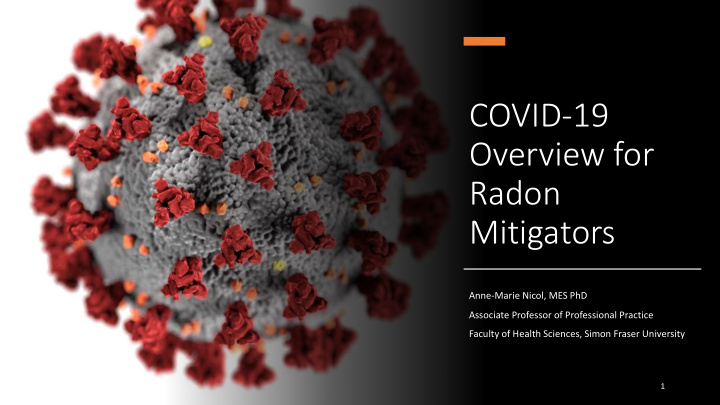



COVID-19 Overview for Radon Mitigators Anne-Marie Nicol, MES PhD Associate Professor of Professional Practice Faculty of Health Sciences, Simon Fraser University 2020-05-25 1
A disclaimer: Our society’s understanding of COVID-19 is constantly changing. Many things remain uncertain and unknown. Transmission electron microscopy of an isolate from the first US COVID-19 patient, US CDC 2020 2020-05-25 2
• Single strand RNA virus • Member of the Coronaviridae family of viruses that What is a includes: Coronavirus? • SARS CoV (2003) • MERS CoV (2015) • 229E • Virions covered by a “halo” or corona of viral spikes • These help the virus attach to a host cell 2020-05-25 3
COVID-19 naming and structure • Co rona vi rus D isease 20 19 = COVID-19 • Virus that causes the disease has been named SARS-CoV-2 • SARS= “Severe acute respiratory syndrome” • Virus surrounded by a lipid membrane • Attaches to human ACE2 receptor cells • Found mostly in the Lungs and Trachea • Some receptors in GI tract 2020-05-25 4
2020-05-25 5
We do we know about COVID-19 origins? • Many animals are coronavirus hosts and intermediate hosts • Origins and “patient(s)” zero still unknown • Potentially exposure through bat guano or exhalation from an intermediate host • Forensic analyses of samples • France and China had cases as early as mid-November • Many stored samples around the world could be tested 2020-05-25 6 Alfonso J. Rodriguez-Morales, pre-print 2020
What do we know SARS-Cov-2 COVID-19 Research about transmission? • Primary transmission through droplet exposure • Coughing or sneezing • Talking • Laughing and Singing • Sharing a meal • Restaurant research • Limited patrons COVID-19 Outbreak Associated with Air Conditioning in Restaurant, • Air conditioned, no windows Guangzhou, China, 2020, Lu et al. Research Letter • Patient A was presymptomatic 2020-05-25 7
Washington State outbreak with clearly identified contact tracing No physical contact Mt Vernon 2.5 hours of singing Shared cookies and tea Choir (n=61) Stacked chairs Symptoms evolved 1-12 days later 87% developed COVID-19, 2 died to date. 2020-05-25 8
Early German company transmission chain Index Patient from Asia had very mild symptoms (headache) for which she took a headache. Had visited parents from Wuhan. Attended meeting In Munich (Webasto- German auto supplier) Employee had meetings and ate lunch in the cafeteria One person was infected after Patient zero passed them a shaker of salt. 2020-05-25 9
Aerosol and fecal transmission routes • Aerosol transmission has not been ruled out • Research shows that the virus can be aerosolized • Toilet plumes can aerosolize viruses • Finding evidence of aerosol transmission is currently difficult 2020-05-25 10
Feces, urine and transmission Fecal and urine transmission Virus found in these fluids, • no evidence of cause are primary outbreaks, yet... Concern may be for “Toilet Plumes” Aerosolized droplets made • from flushing with lid up SARS (2003) did have one major fecal tranmission outbreak. 2020-05-25 11
SARS 2003 outbreak Lessons learned from SARS Cov-1 research Amoy Gardens Index SARS case had diarrhea 321 people were infected total in the buildings 42 died of SARS At least 4 towers impacted 2020-05-25 12 Wong et al. Scientific Models in the SARS Research and Biology
Contaminated surfaces (aka Fomite transmission ) Stephens et al. 2019 https://link -springer- com.proxy.l ib.sfu.ca/ar ticle/10.10 07/s40726- 019-00123- 6/figures/1 2020-05-25 13
Fomite transmission varies by viral persistence Surface Persistence of virus on surface Paper/Cardboard Paper and tissue: up to three hours Cardboard: up to 24 hours Stainless Steel 3-4 days Copper and Aluminum Up to 4 hours Plastic At least 3-4 days* - could be longer Wood Up to 2 days Glass Up to 4 days Cloth Up to 2 days Non-porous and and less conductive surfaces allow virus remain longer 2020-05-25 14
Most well established- Cough, shortness of breath fatigue, muscle aches, fever >39.4 Other known symptoms: What are the • Headaches • Loss of smell • Diarhhea/nausea, loss of appetite symptoms of • “COVID toes” –in children • Runny nose COVID-19? • Sore throat • Chills Other issues • Stroke (in younger people) • Cardiac involvement • Rashes 2020-05-25 15
• Evidence exists of transmission BEFORE more severe symptoms develop Asymptomatic and • Estimates suggest 44% or more transmissions may occur PRIOR to onset of symptoms Pre-symptomatic Preliminary research only, from different countries with small sample sizes • • Younger people generally have milder symptoms Transmission • Bottom Line: you don’t need to be sick to transmit the virus to someone possible else • Transmission more likely and successful when people are symptomatic 2020-05-25 16
Handwashing with soap works really well, why? • Enveloped virus with a fatty lipid layer around the Preventing viral outside • Soap degrades lipid layer, breaking up the virus transmission • Needs time though- hence the “at least 20 seconds” • Rinse broken down viral particles down the drain 2020-05-25 17
Preventing transmission Staying at home works really well continued - staying away from others reduce risk considerably Social distancing works really well - Staying at least 6 feet away keeps to avoid droplets Image from: NYT - Aerosol transmission still unclear- research on-going https://www.nytimes.com/interactive/20 20/04/14/science/coronavirus- Besides sneezing and coughing, laughing, eating, singing- all generate transmission-cough-6-feet-ar-ul.html droplets, 2020-05-25 18
Cleaning and Disinfection • Bleach solutions work very well • Alcohol >60% useful • Surfaces in bathrooms should be sanitized frequently if used by people who are going out • Shared objects important • Phones • Pens • Touch screens 2020-05-25 19
Check your disinfecting products here, many common products are NOT approved for COVID 2020-05-25 20
https://www.canada.ca/en/public-health/services/diseases/2019-novel-coronavirus- infection.html?topic=tilelink 2020-05-25 21
Thank-you! Any questions? 2020-05-25 22
Recommend
More recommend